Programmable logic controllers (PLCs) play a crucial role in industrial automation and process control. PLCs control analogue and digital sensors, a wide range of actuators, and communicate through complicated interfaces in various protocols.
PLCs are now popular in digital applications, thanks to the Industrial Internet of Things (IIoT). The programmable logic controller is commonly used in industries to perform sequential and repeating processes. The newest PLCs play an important role in Industry 4.0 and successfully improve the plants.
What Are PLCs Used For?
As you may already know, a programmable logic controller, commonly abbreviated to PLC, is an electronic device that controls the operation of a machine or process and is made of solid-state. PLCs can receive input data and pass on operating instructions via their outputs. A PLC is typically compact and has a key role in automating essential processes.
Three main roles of Programmable Logic Controllers:
- to monitor and control industrial automation processes;
- to carry out tasks relating to testing and measuring;
- to execute process-type functions, such as those used with HVAC systems.
To carry out these functions, each PLC is equipped with sensors and/or other input devices, through which it receives the data needed for the controller to make its decision based on logic. The PLC will subsequently output control instructions to a connected mechanical or electrical system.
As such, a PLC may be categorised as a type of embedded system, which comprises both computer memory and processing capability with input-output (IO) devices, which makes them akin both to hardwired, relay-based logic, and PC-based logic. The most common types of PLCs are: modular, compact and rack programmable logic controllers.
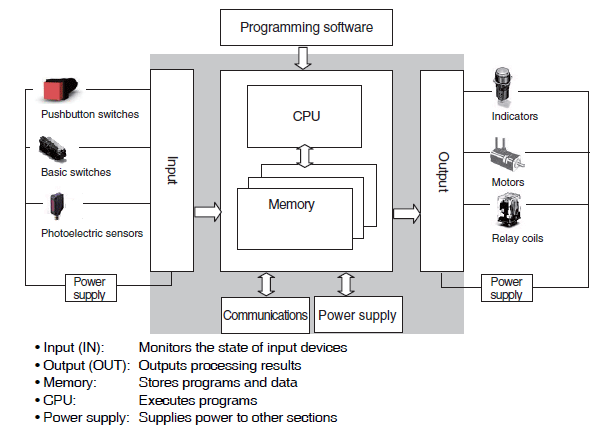
PLCs In Industrial Automation
Programmable Logic Controllers are common solutions that are used in many industrial sectors. The applications can vary depending on where they will be used – in domestic or professional environments.
Industrial automation’s purpose is to control devices that run advanced functionalities (including IIoT connectivity and machine reconfiguration) whilst facilitating the ability of human workers to make informed decisions about machines or operations. The overall goal of an effective industrial automated environment is to increase overall productivity and quality of work. Modern industrial automation depends on real-time feedback from machines and operational data and sophisticated interactions between many digital devices, which means that the programmable logic controller plays a vital part.
The PLC improves factories at control level, taking and returning information from devices at the field level and sometimes passing on data to supervisory level systems, such as SCADA and Historian. Advanced PLC units can even carry out such supervisor level activities themselves.
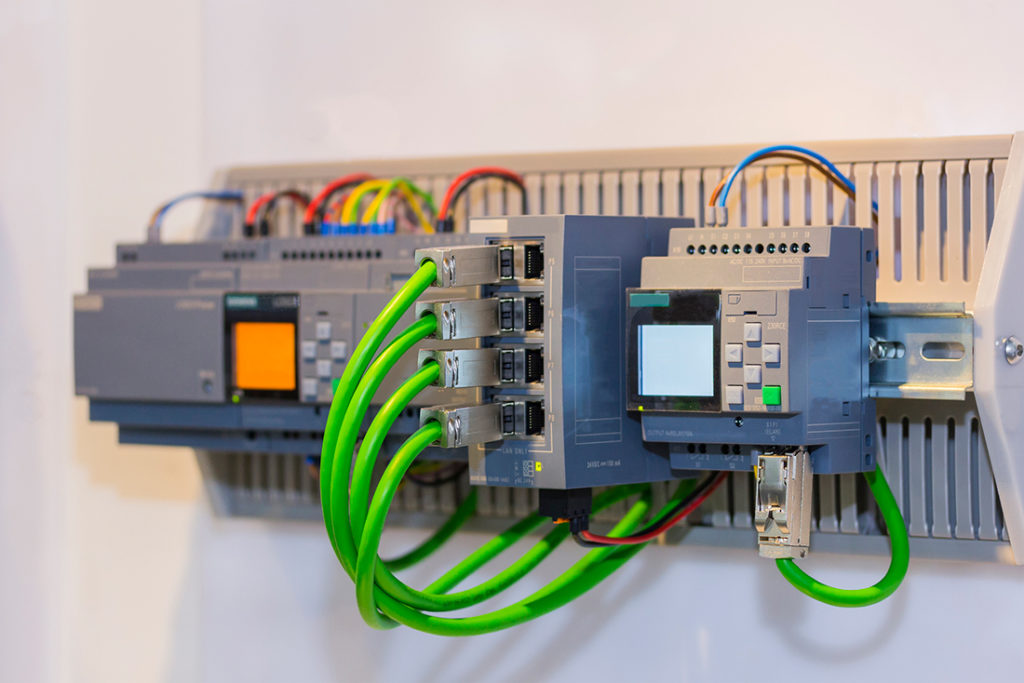
The Most Common Applications of PLCs in Industrial Sector
PLCs are used in a variety of industrial applications, here are some examples:
- Factories
- Heating control systems
- Traffic light controls
- Automatic gate systems
- Packaging machines
- Medical applications
- Lifts and escalators
PLCs in Test and Measurement
In addition to their role in industrial digital control, PLCs are also used in testbench control (as part of the product development process) and laboratory measurement tasks. The PLC can quickly and accurately obtain measurement data. In such testing and measurement tasks, PLCs operate through real-time processing, where they measure the delay in milliseconds between a field device measurement and its data collection.
With intelligent peripheral devices and input-output units, the signal collection has become advanced and amplified through analogue and digital input sources. Input-output devices with an integrated PLC unit offer particularly valuable benefits, being compatible with human-machine interfaces (HMIs) running Windows or Linux operating systems and offering ethernet connectivity. Input-output devices can also be used with PLCs to collect data directly from their own sensors and remote input-output equipment.

Modular PLCs are another option for testing and measurement applications. Such devices are typically built of several modules that each perform a different function and a CPU unit that controls the processor and memory. There are a variety of module options available for such PLCs. There may be a separate power source module or additional modules for input-output functions or to facilitate network communication. The unit itself may be integrated, with all of the modules housed within a single enclosure, which offers benefits such as a more compact footprint, whereas PLCs with non-integrated modular set-ups allow for greater versatility, with an easier connection between multiple modules.
At Distrelec, our selection includes programmable logic controllers from all of the leading manufacturers, including Siemens, Eaton, Crouzet, Schneider Electric and Omron so you can be confident of purchasing an item of the highest quality available.
The Modern PLCs – Brands and Products
The PLC was originally conceived to replace hardwired logic based on relays and drum sequencers. Since their inception, however, the capabilities of PLCs have greatly extended, with modern units including PID (proportional-integral-derivative) control and many other advanced functionalities. The current breed of PLCs may carry out complicated and adaptive routines. This is thanks, partially, to the ever-decreasing size and increasing power of semiconductor chips, which has enabled these small computers to become progressively more intelligent.
The modern PLC may take the form of a simple integrated chip (IC) device, or a simple microcontroller-based unit, requiring little power, through to a rack-mounted combination of controller subcomponents. The most complex PLC set-ups can rival the capabilities of general-purpose computers for industrial control purposes, although the PLC offers key advantages in reliability and real-time performance.
Today’s most popular advanced PLCs may include an impressive array of technologies, including integrated motion control, vision systems and communication software. PLCs are also increasingly integrated into HMIs. You can read more about HMIs and how to select the ideal one for your applications.
Eaton
Eaton has ‘the most advanced’ nano programmable logic controller on the market which is called the easyE4. It comes with 12 I/O points and can be expanded to a network of up to 188. The XC300 compact PLC is expandable and uses the XN300 modular I/O architecture. It excels in high-speed applications that require the most programming freedom.
Eaton’s mission is to improve the environment and offer sustainable solutions by using power management, wireless, sensing, lighting, motor control and displays. See the whole range of Eaton’s programmable logic controllers.

The EasyE4 PLC offers an ‘easy’ system solution with a connection to the Cloud. It has 12 I/O and can be expanded to a network of up to 188 I/O points, making it perfect for lighting, energy management, industrial control, irrigation, pump control, HVAC, and home automation applications. The PLC 8DI has a user-friendly programming environment with four programming languages such as ST, FBD, LD and EDP. It offers maximum flexibility, with up to 11 local expansion modules per base unit.
Eaton’s solutions are perfect for a variety of applications:
- Internet of Things (IoT)
- Industrial Automation
- Transportation
- Alternative Energy
- Maintenance & Safety
- Robotics
- Medical
Eaton and IoT
Real-time connectivity from IoT monitoring is essential for productivity and uptime. According to Eaton, when a fault is found, being able to access your system from your device has numerous advantages, such as:
- Ability to diagnose and troubleshoot problems remotely. Remote access to the network allows facility engineers who are travelling or are not currently at the facility to observe faults or look at data to determine the source of the incident.
- Access the nano PLC’s programme from outside the site to change values and save money.
- Guarantee that devices are running the correct versions; remote access component specific information such as firmware level is available.
IoT connectivity for HVAC system
One of the most important aspects of the Internet of Things is connecting machines to the internet. It enables data to be exchanged across devices, viewed remotely, and used by apps. The Eaton devices from the easyE4, which has a built-in web server utility, make this even easier. A user can interact with the PLCs using a web browser.
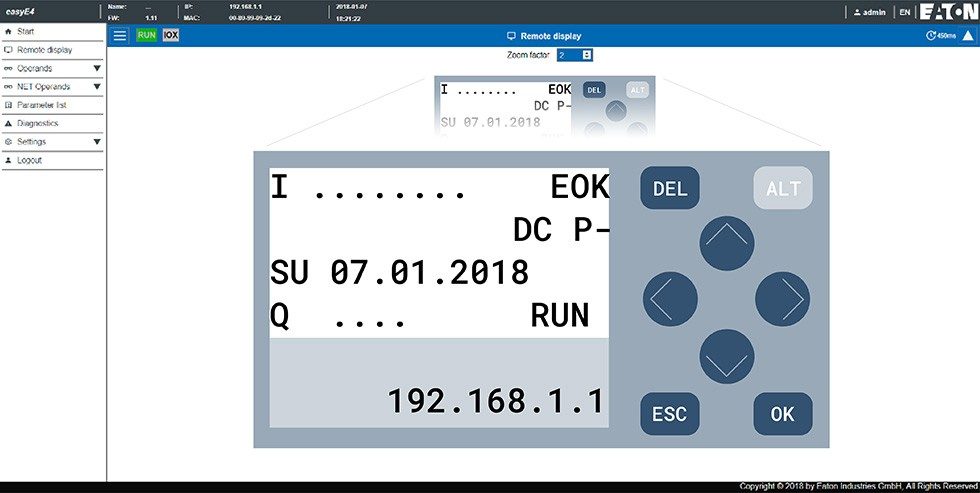
The web server for the easyE4 contains interactive pages that allow users to execute the same operations by clicking buttons on the screen as if they were pressing buttons on the device itself. Similarly, while the device is running, there are displays to see and set operands useful for troubleshooting system issues. The diagnostics tab on the homepage is another useful troubleshooting tool, as it displays any errors that the device detects.
Availability of monitor programs
Eaton’s new easyE4 systems enable interaction with the web page through the internet and allow the user to change programs and values online. When developing a programme to automate an application, the programmer almost always makes mistakes. To avoid troubleshooting, the user can use the internet to remotely detect errors in the software and make the appropriate changes to the program’s values.
Besides that, for the longevity of HVAC systems, it is crucial to have an engineer or certified individual able to remotely connect to the system to assess, diagnose, and make modifications. However, when the specialists aren’t on-site, problems with the HVAC system can occur. The first symptom of difficulty in an older system, which may not be accessible via the internet, can cause havoc for building management.
Crouzet
Crouzet designs and manufactures mechatronic components for demanding applications in the aerospace and transportation, energy, construction, and machinery industries. The brand has an extensive selection of automaton controllers and relays.
Crouzet’s range of controllers:
- Telecontrollers
- Nano-PLCs
- Communicating Logic Controllers
- Logic Controllers
- Slim Logic Controllers
For more details and specifications about each category, click to see the Crouzet Automation & Control brochure.
In Crouzet’s offer there is a Millenium 3 logic controller that controls and monitors installations up to 50 inputs/ output. It allows for machine monitoring, access control, light and pump management, water purification, solar tracking and more.
Millennium 3 is simple to use with its intuitive programming and simulation mode that provides quick and easy access. It is based on basic functions and dedicated ones, such as pressure, solar tracking, pump rotation, etc. Available in 5 languages (English, German, French, Italian and Spanish).
From Distrelec, you can buy a Millenium 3 starter kit with one expandable Millenium 3 (XD26), one USB link cable: PC →Millenium 3 and one interactive CD ROM including the software workshop, application library and technical brochures, 1 CD-ROM including the library of specific functions.
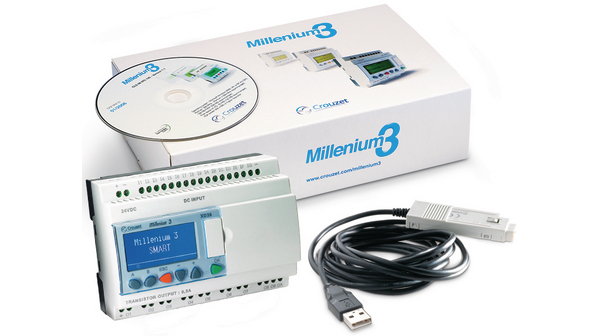
All of the small-scale automation applications will benefit from the communicative logic controller – Millennium Evo. It is possible to access Evo’s front control panel by using your PC, laptop, or mobile device.
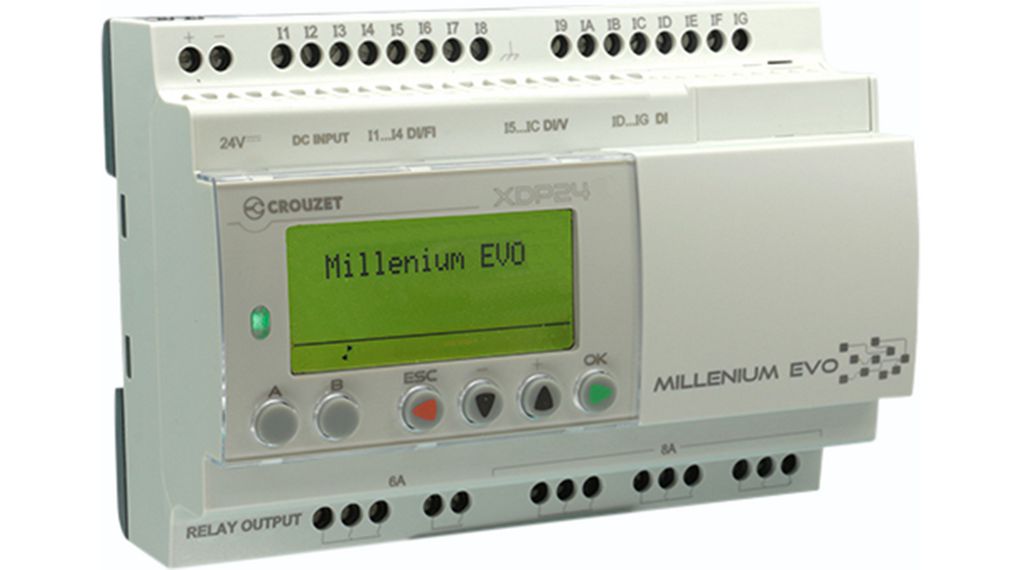
One of the Millennium Evo controllers is Programmable Logic Controller 16DI (8D/A) 8DO 28.8VDC, Crouzet and its features are: up to 44 I/Os – 16 DI (4 HighSpeed / 8 AI), 8 DO Wireless programming & Control with bluetooth Interface and Crouzet Virtual Display, Modbus RTU Network (Slave), Local datalog management, up to 1000 programing blocks with intuitive Crouzet Soft to go from simple to complex applications.
Third series presents the smallest logic controller ever – Millennium Slim. If you are looking for a product that offers space reduction, this logic controller will fulfil your requirements with a 17.5mm body that fits into any panel or machine. Besides that, it is highly configurable, can be connected wirelessly through bluetooth, and has an easier to use virtual display.
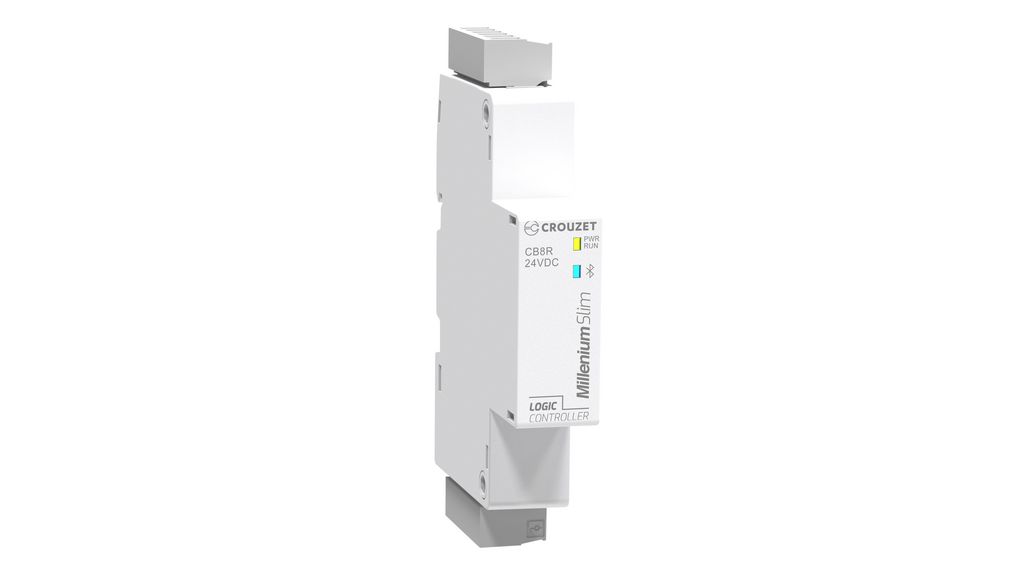
Listen to the review from Crouzet to find out all of the necessities and advantages about Millenium Slim, the smallest PLC.
There is also an option to design your own controller. Crouzet provides personalisation of their devices. You can fully design by changing colour, marking and adding a logo to your controller that will suit your application aesthetically and functionally. Read more here.
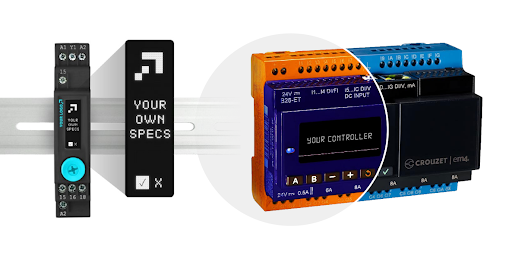
Siemens
Siemens offers controllers from the SIMATIC S7-1200, SIMATIC S7-1500 and LOGO! 8.3 as well as ET 200SP series.
The SIMATIC S7-1200 controllers are space-saving automation systems with expanded connectivity possibilities and integrated technological solutions. They are capable of performing well in the low and medium performance ranges.
Siemens SIMATIC S7-1200 programmable logic controllers features:
- Flexibility
- Safety integrated
- Technology integrated
- Edge integration
- Scalability
- Engineering in TIA Portal
- Security integrated
- Dedicated functionalities
The SIMATIC S7-1500 PLCs provide top performance and built-in future viability. Any of the most complex machine designs are accessible thanks to this gadget and its modular construction. As per Siemens: ‘innovative controller technology will continue to be the heart of a digital factory’. Siemens’ contemporary controllers are ideal for factory automation as well as medium- and high-end machines.
According to Siemens, the ‘heart’ of SIMATIC S7-1500 PLCs is the Central Processing Unit (CPU) that executes the user program and connects the controller with other automation components.
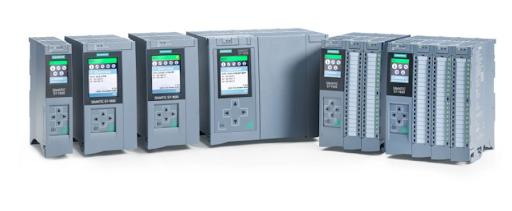
Siemens allows for integration of the SIMATIC S7-1500 Technology-CPU (T-CPU) into the TIA Portal (see figure 4). Customers can configure the T-CPU in the TIA Portal without the need of specialist knowledge of motion. You can read more about it here.
Furthermore, a perfect interaction is possible between SIMATIC S7-1500 and SIMATIC ET 200MP. These SIMATIC ET 200MPs are designed along with the S7-1500 CPUs and are certified according to EN 61508. These IO systems are easy to integrate and designed for long-term reliable, cost-efficient use. Besides the configuration to S7-1500, they also connect to PROFINET or PROFIBUS.

For maximum performance in central configuration, there are the ET 200SPs – the perfect compact IO system for the control cabinet. It is exemplified by a modular and scalable station with the SIMATIC S7-1500 I/O modules. It enables safety-related communication.
Siemens’ last PLCs offer focus on LOGO! These automation solutions allow for fast control of basic tasks. However, it is not only a simple controller. With LOGO! now there is possible connectivity through the Cloud (watch the video below) and 8.3 data can be transferred to the cloud in its entirety. With the LOGO! series you have access to the Internet of Things (IoT).
LOGO! 8.3 intelligent microcontrollers can now control even the most complicated industrial systems in real time with simple programming and data on the cloud via AWS or LOGO! Soft Comfort software. This kind of remote monitoring of machine performance, regardless of location and in real-time, has never been attempted before. Siemens LOGO! 8.3 engineering software with cloud connectivity is designed for data analysis, messages, notifications, and alarms. Find out more about its capabilities on the Siemens website.

Schneider Electric
Schneider Electric has a comprehensive selection of PLCs for Industrial Machines representing innovation, with a full spectrum of solutions to fulfil your automation requirements. One of their series – Modicon PLCs and PACs (Programmable Automation Controllers) regulates and monitors industrial operations in a way that is sustainable, adaptable, efficient, and secure.
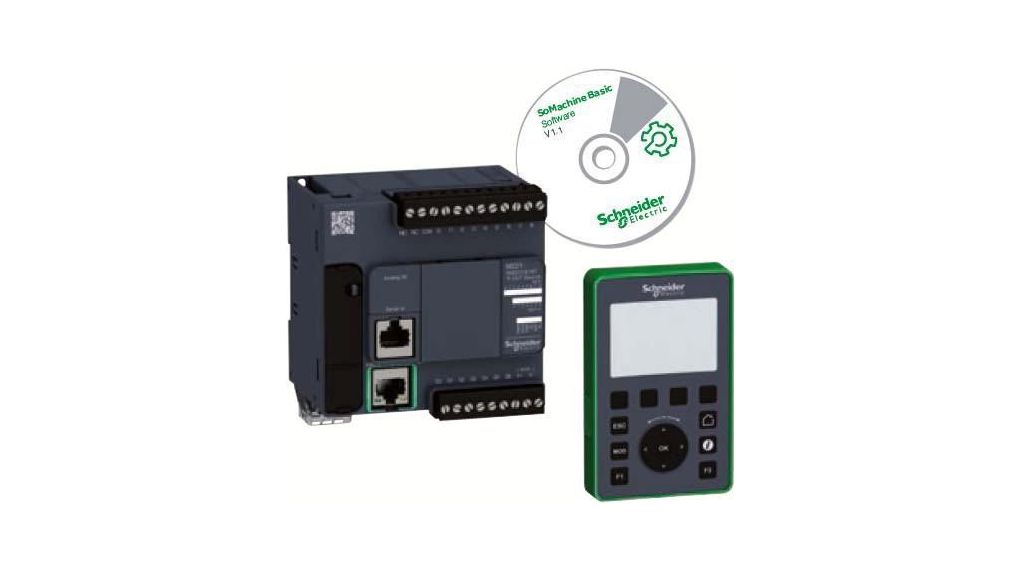
The Modicon M221 logic controller is the best in its class. It is available in brick or book style, and it requires very little setup and gives a lot of flexibility. Connect a simple remote operator panel for rapid machine visualisation and maintenance. At Distrelec you can get it as a starter kit with Schneider SoMachine software V1.1 and HMI device THM2GDB.
Edge technology and Big Data analysis
Edge technology is provided by Schneider Electric’s PLCs and PACs, which are enhanced by Ethernet connectivity, built-in cybersecurity, and processing capacity to handle Big Data analysis and protect against new vulnerabilities among linked industrial assets, across devices, and into the cloud.
For configuring, developing and commissioning the whole machine in a single software environment, Schneider Electric provides EcoStruxure Machine Expert. It is a single-software environment for configuring the machine, including logic, motion control, robotics/mechatronics, simulation, diagnostics, intelligent motor and load management and drives, HMI (Vijeo Designer), IIoT, and related network automation functions.

It is compatible with Modicon M221, Modicon TM2, TM3 and I/O modules. Read more about EcoStructure Machine Expert here.
If you are looking for PLCs perfect for simple automation systems, Schneider Electric offers Zelio Logic, an easy-to-use alternative to solutions that rely on cabled logic or dedicated cards. Zelio logic smart relays offers two product lines: compact models with set configurations and modular models with extension modules. The smart relays have a PID function for HVAC applications and can communicate through 2G/3G modems.
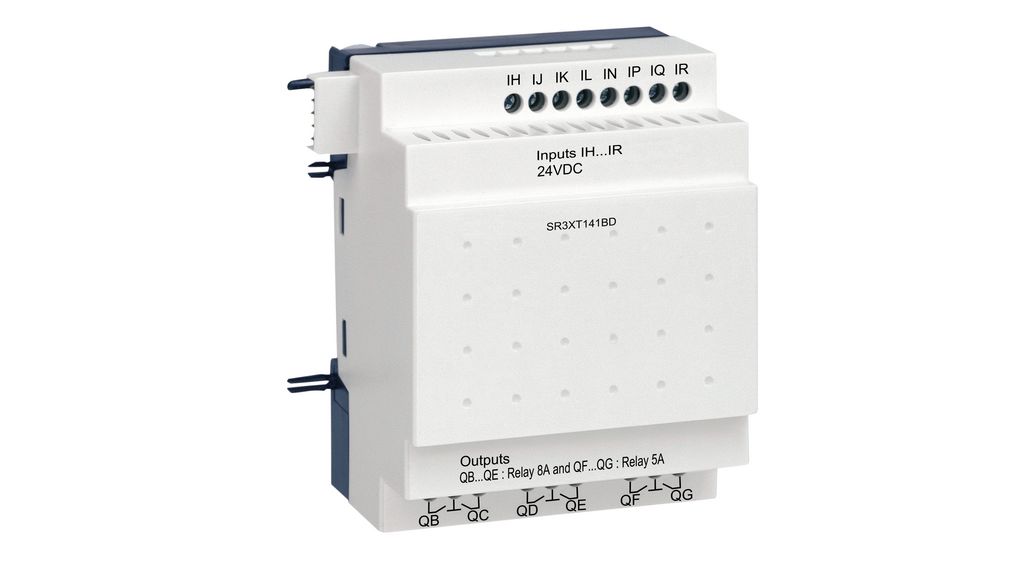
OMRON
The new programmable logic controllers are available with effortless Support Software to flexibly handle applications ranging from small-scale equipment to whole production lines. Some of the advanced PLCs that can improve the manufacturing are from the SYSMAC series, including CP / CJ2 / NJ / NX series.
Sysmac is an integrated automation platform that allows users to control and manage an automation plant completely. The Omron’s Machine Controller series is at the heart of this platform, providing synchronous control of all machine units as well as sophisticated features like motion, robotics, and database connectivity. This multidisciplinary approach allows you to streamline solution architecture, decrease programming time, and boost productivity.

At Distrelec you can find a very extensive range of PLCs from Omron. Modern machine control necessitates microsecond-level synchronisation of motion axes across the system. For a wide range of in- and outputs, the NX I/O system provides this timing accuracy and repeatability. Its ultra-fast internal bus system is synchronised with the EtherCAT network’s Distributed Clock, allowing for system-wide deterministic I/O.
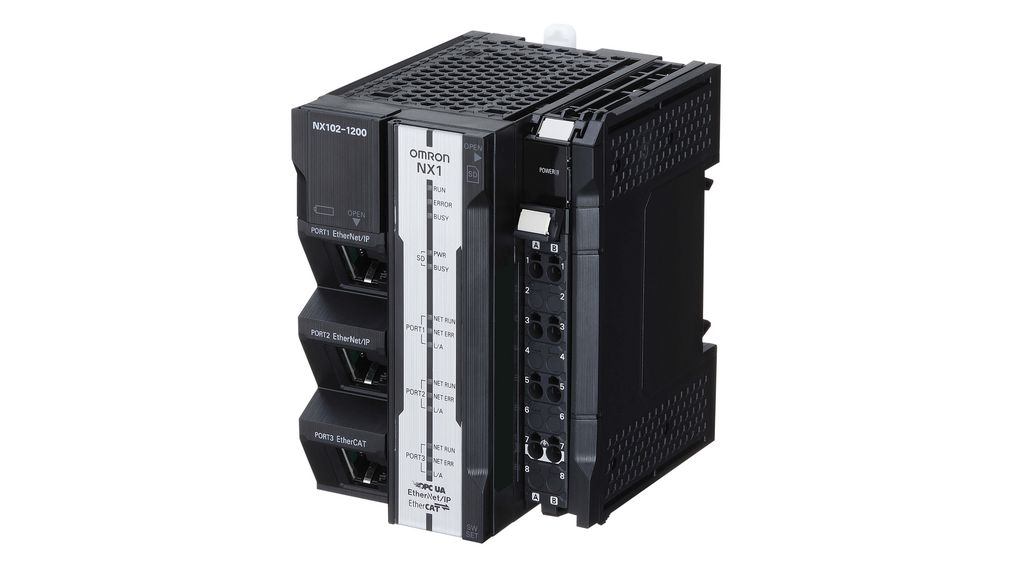
Features: Fast and accurate control by synchronising all machine devices with the PLC and Motion Engines, three built-in industrial Ethernet ports, OPC UA server functionality, up to 12 axes of control via EtherCAT, up to 32 local NX I/O Units, DC power supply without battery backup, fully conforms to IEC 61131-3 standard programming.
Another PLC from NX series, is NX1P that offers advanced motion control and networks for onsite IoT in a compact entry model.
The NX1P machine controller completes the NX/NJ machine controller family, providing the same capability in a smaller package. The NX1P allows synchronised control of all machine devices such as motion, I/O, safety, and vision from a single Integrated Development Environment.
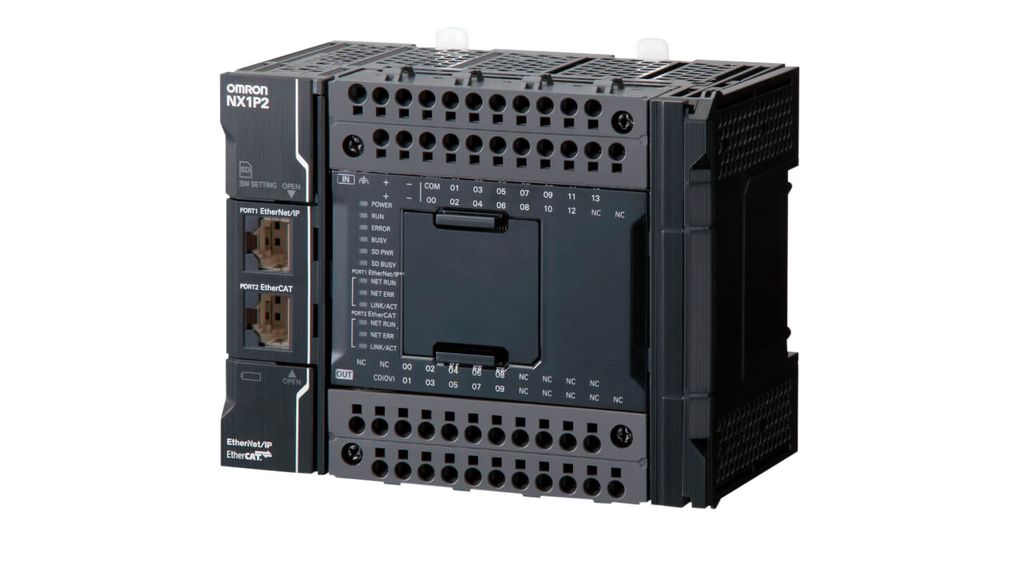
To achieve high cost performance, there are Ethernet communication and 4-axis positioning functions built in the SYSMAC CP controller. Such micro PLCs are perfect for controlling small machines.
The CJ2 is part of the SYSMAC CJ-series CPU Unit that has improved performance and functionality over the CJ1.The CJ2 CPU Units provide more data memory, a multifunctional Ethernet interface, tag access, and a USB port.
The NJ CPU Units offer integration of logic and motion in one CPU, fast and accurate control by synchronising all EtherCAT devices. Furthermore, they offer speed without compromising on reliability, robustness, electric gear and cam synchronisation.
For more technical information, Omron has prepared a PLC basics guide that can help describe the terminology of SYSMAC PLCs.
If the solutions described above did not fulfil your application requirements, Distrelec is a distributor offering alternative PLCs from other brands, such as Mitsubishi Electric, Allen-Bradley and Jumo. Also, in addition to PLCs, you can find useful PLC starter kits, PLC expansion kits and PLC accessories, such as bus adaptors, programming cables, dedicated PLC memory cards and battery units.
FAQs
PLC, refers to a programmable logic controller, which is an industrial sector programmable computing device, commonly employed for managing electromechanical processes.
There are plenty of brands that are selling different types of PLCs, from modular, nano, mini, and ones with analog or relay outputs. One of the most popular in the industry is the Siemens Simatic PLC that we mentioned in this article.
There are five standard PLC programming languages, the most common ones are Ladder Logic, Structured Text, Sequential Function Charts, Function Block Diagram and Structured Control Language.
PLCs have made it possible for industry to have electronic, logical control, which is critical in these times. In order to reduce labour costs, time, and waste, PLCs oversee and manage automated production processes, such as assembling lines, robotic devices, and other machine operations.










